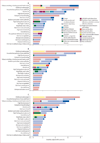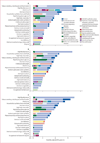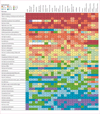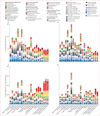A comparative risk assessment of burden of disease and injury attributable to 67 risk factors and risk factor clusters in 21 regions, 1990-2010: a systematic analysis for the Global Burden of Disease Study 2010
- PMID: 23245609
- PMCID: PMC4156511
- DOI: 10.1016/S0140-6736(12)61766-8
A comparative risk assessment of burden of disease and injury attributable to 67 risk factors and risk factor clusters in 21 regions, 1990-2010: a systematic analysis for the Global Burden of Disease Study 2010
Erratum in
- Lancet. 2013 Apr 13;381(9874):1276
- Lancet. 2013 Feb 23;381(9867):628. AlMazroa, Mohammad A [added]; Memish, Ziad A [added]
Abstract
Background: Quantification of the disease burden caused by different risks informs prevention by providing an account of health loss different to that provided by a disease-by-disease analysis. No complete revision of global disease burden caused by risk factors has been done since a comparative risk assessment in 2000, and no previous analysis has assessed changes in burden attributable to risk factors over time.
Methods: We estimated deaths and disability-adjusted life years (DALYs; sum of years lived with disability [YLD] and years of life lost [YLL]) attributable to the independent effects of 67 risk factors and clusters of risk factors for 21 regions in 1990 and 2010. We estimated exposure distributions for each year, region, sex, and age group, and relative risks per unit of exposure by systematically reviewing and synthesising published and unpublished data. We used these estimates, together with estimates of cause-specific deaths and DALYs from the Global Burden of Disease Study 2010, to calculate the burden attributable to each risk factor exposure compared with the theoretical-minimum-risk exposure. We incorporated uncertainty in disease burden, relative risks, and exposures into our estimates of attributable burden.
Findings: In 2010, the three leading risk factors for global disease burden were high blood pressure (7·0% [95% uncertainty interval 6·2-7·7] of global DALYs), tobacco smoking including second-hand smoke (6·3% [5·5-7·0]), and alcohol use (5·5% [5·0-5·9]). In 1990, the leading risks were childhood underweight (7·9% [6·8-9·4]), household air pollution from solid fuels (HAP; 7·0% [5·6-8·3]), and tobacco smoking including second-hand smoke (6·1% [5·4-6·8]). Dietary risk factors and physical inactivity collectively accounted for 10·0% (95% UI 9·2-10·8) of global DALYs in 2010, with the most prominent dietary risks being diets low in fruits and those high in sodium. Several risks that primarily affect childhood communicable diseases, including unimproved water and sanitation and childhood micronutrient deficiencies, fell in rank between 1990 and 2010, with unimproved water and sanitation accounting for 0·9% (0·4-1·6) of global DALYs in 2010. However, in most of sub-Saharan Africa childhood underweight, HAP, and non-exclusive and discontinued breastfeeding were the leading risks in 2010, while HAP was the leading risk in south Asia. The leading risk factor in Eastern Europe, most of Latin America, and southern sub-Saharan Africa in 2010 was alcohol use; in most of Asia, North Africa and Middle East, and central Europe it was high blood pressure. Despite declines, tobacco smoking including second-hand smoke remained the leading risk in high-income north America and western Europe. High body-mass index has increased globally and it is the leading risk in Australasia and southern Latin America, and also ranks high in other high-income regions, North Africa and Middle East, and Oceania.
Interpretation: Worldwide, the contribution of different risk factors to disease burden has changed substantially, with a shift away from risks for communicable diseases in children towards those for non-communicable diseases in adults. These changes are related to the ageing population, decreased mortality among children younger than 5 years, changes in cause-of-death composition, and changes in risk factor exposures. New evidence has led to changes in the magnitude of key risks including unimproved water and sanitation, vitamin A and zinc deficiencies, and ambient particulate matter pollution. The extent to which the epidemiological shift has occurred and what the leading risks currently are varies greatly across regions. In much of sub-Saharan Africa, the leading risks are still those associated with poverty and those that affect children.
Funding: Bill & Melinda Gates Foundation.
Copyright © 2012 Elsevier Ltd. All rights reserved.
Figures






Comment in
-
Global burden of cardiovascular disease.Nat Rev Cardiol. 2013 Feb;10(2):59. doi: 10.1038/nrcardio.2012.194. Epub 2013 Jan 8. Nat Rev Cardiol. 2013. PMID: 23296068 No abstract available.
-
Annual deaths attributable to physical inactivity: whither the missing 2 million?Lancet. 2013 Mar 23;381(9871):992-3. doi: 10.1016/S0140-6736(13)60705-9. Epub 2013 Mar 22. Lancet. 2013. PMID: 23668575 No abstract available.
-
Annual deaths attributable to physical inactivity: whither the missing 2 million? - Authors' reply.Lancet. 2013 Mar 23;381(9871):993. doi: 10.1016/S0140-6736(13)60706-0. Epub 2013 Mar 22. Lancet. 2013. PMID: 23668577 No abstract available.
-
Alcohol-related road traffic injury and Global Burden of Disease 2010.Lancet. 2013 Sep 28;382(9898):1092-3. doi: 10.1016/S0140-6736(13)62014-0. Lancet. 2013. PMID: 24075041 No abstract available.
-
Identifying corrections-is there a better way?Addiction. 2015 Jul;110(7):1207. doi: 10.1111/add.12924. Epub 2015 Apr 30. Addiction. 2015. PMID: 25931008 No abstract available.
Similar articles
-
Global, regional, and national comparative risk assessment of 84 behavioural, environmental and occupational, and metabolic risks or clusters of risks for 195 countries and territories, 1990-2017: a systematic analysis for the Global Burden of Disease Study 2017.Lancet. 2018 Nov 10;392(10159):1923-1994. doi: 10.1016/S0140-6736(18)32225-6. Epub 2018 Nov 8. Lancet. 2018. PMID: 30496105 Free PMC article.
-
Global, regional, and national comparative risk assessment of 79 behavioural, environmental and occupational, and metabolic risks or clusters of risks, 1990-2015: a systematic analysis for the Global Burden of Disease Study 2015.Lancet. 2016 Oct 8;388(10053):1659-1724. doi: 10.1016/S0140-6736(16)31679-8. Lancet. 2016. PMID: 27733284 Free PMC article.
-
Global, regional, and national comparative risk assessment of 79 behavioural, environmental and occupational, and metabolic risks or clusters of risks in 188 countries, 1990-2013: a systematic analysis for the Global Burden of Disease Study 2013.Lancet. 2015 Dec 5;386(10010):2287-323. doi: 10.1016/S0140-6736(15)00128-2. Epub 2015 Sep 11. Lancet. 2015. PMID: 26364544 Free PMC article.
-
Alcohol use and burden for 195 countries and territories, 1990-2016: a systematic analysis for the Global Burden of Disease Study 2016.Lancet. 2018 Sep 22;392(10152):1015-1035. doi: 10.1016/S0140-6736(18)31310-2. Epub 2018 Aug 23. Lancet. 2018. PMID: 30146330 Free PMC article. Review.
-
Global burden of disease attributable to mental and substance use disorders: findings from the Global Burden of Disease Study 2010.Lancet. 2013 Nov 9;382(9904):1575-86. doi: 10.1016/S0140-6736(13)61611-6. Epub 2013 Aug 29. Lancet. 2013. PMID: 23993280 Review.
Cited by
-
Higher dietary inflammatory index linked to increased risk of hypertension: a systematic review and dose-response meta-analysis.Eur J Clin Nutr. 2024 Oct 24. doi: 10.1038/s41430-024-01530-9. Online ahead of print. Eur J Clin Nutr. 2024. PMID: 39448814 Review.
-
Non-optimal temperature-attributable mortality and morbidity burden by cause, age and sex under climate and population change scenarios: a nationwide modelling study in Japan.Lancet Reg Health West Pac. 2024 Oct 8;52:101214. doi: 10.1016/j.lanwpc.2024.101214. eCollection 2024 Nov. Lancet Reg Health West Pac. 2024. PMID: 39444715 Free PMC article.
-
An updated modeling framework to simulate Los Angeles air quality - Part 1: Model development, evaluation, and source apportionment.Atmos Chem Phys. 2024 Feb 23;24(4):2345-2363. doi: 10.5194/acp-24-2345-2024. Atmos Chem Phys. 2024. PMID: 39440024
-
Composite dietary antioxidant index and abdominal aortic calcification: a national cross-sectional study.Nutr J. 2024 Oct 22;23(1):130. doi: 10.1186/s12937-024-01029-w. Nutr J. 2024. PMID: 39438863 Free PMC article.
-
Development of a wastewater based infectious disease surveillance research system in South Korea.Sci Rep. 2024 Oct 19;14(1):24544. doi: 10.1038/s41598-024-76614-4. Sci Rep. 2024. PMID: 39427054 Free PMC article.
References
-
- Doll R, Peto R. The causes of cancer: quantitative estimates of avoidable risks of cancer in the United States today. J Natl Cancer Inst. 1981;66:1191–1308. - PubMed
-
- Peto R, Boreham J, Lopez AD, Thun M, Heath C. Mortality from tobacco in developed countries: indirect estimation from national vital statistics. Lancet. 1992;339:1268–1278. - PubMed
-
- Murray C, Lopez AD. The global burden of disease: a comprehensive assessment of mortality and disability from diseases, injuries, and risk factors in 1990 and projected in 2020. Cambridge: Harvard University Press; 1996.
-
- Murray CJ, Lopez AD. On the comparable quantification of health risks: lessons from the Global Burden of Disease Study. Epidemiology. 1999;10:594–605. - PubMed
-
- WHO. Geneva: World Health Organization; 2002. The World Health Report 2002—Reducing Risks, Promoting Healthy Life. - PubMed
Publication types
MeSH terms
Grants and funding
LinkOut - more resources
Full Text Sources
Other Literature Sources
Medical

